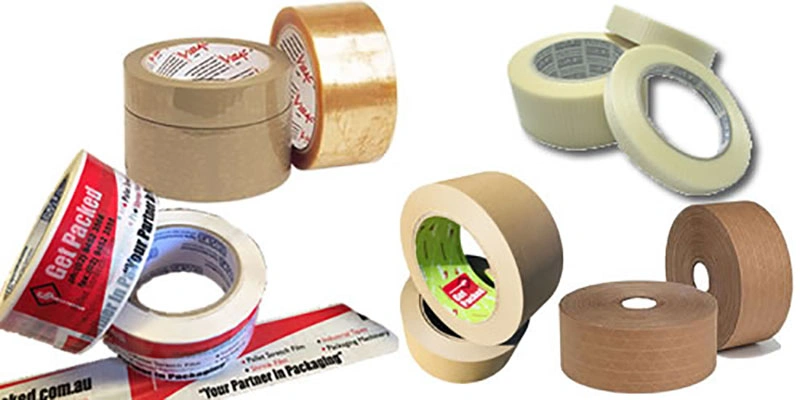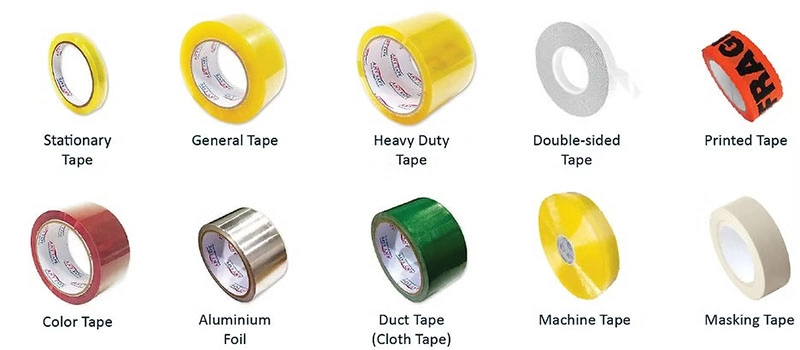Packaging tape may seem like a minor consideration, but the wrong tape can cause cartons to crack, damage goods, and ultimately erode your brand reputation. For exporters, the right tape directly determines whether goods arrive safely. This article will help you understand tape types, usage scenarios, and testing methods.
Last updated: September 2025 | Estimated reading time: 9 minutes

This article will answer your questions
- What is packaging tape
- Types of packaging tape and their advantages and disadvantages
- How a tape’s adhesive and backing affect performance
- How to choose tape based on carton weight and type
- Which tapes are suitable for low temperature or high humidity environments?
- How to read tape specifications
- How to quickly test tape before shipment
What is packaging tape?
Packaging tape is a type of adhesive tape used to seal boxes and secure goods. It is made from plastic polymers, such as polypropylene. Its advantages include high strength, abrasion resistance, and excellent adhesion, ensuring the integrity of goods during transportation and storage.
Main packaging tape types

Acrylic tape:
Acrylic tape with water-based glue on BOPP film.
Waterproof, weather-resistant, aging-resistant, not easy to turn yellow, suitable for long-term storage, suitable for long-term carton storage.
Hot-melt/BOPP tape:
Hot-melt tape uses a rubber-based adhesive.
It has a fast tack time and performs well at low temperatures, making it suitable for high-speed carton sealing machines. It is environmentally friendly and requires no drying time. It is used in electronics, packaging, and industrial manufacturing.
Solvent-based tape:
Solvent-based tape uses natural rubber adhesive.
It has strong adhesion, even sticking to dust and recycled cardboard. It’s suitable for extreme environments, such as low temperatures and high humidity. However, it’s expensive and environmentally unfriendly. It’s commonly used in industries such as the military and medical sectors, where high adhesion is crucial.
Water-activated tape (Gummed Tape):
Water-activated tape requires water to adhere.
Once applied, it fuses with the carton fibers, forming a tamper-evident seal. Gummed tape is strong, environmentally friendly, and recyclable, making it a popular choice for carton sealing and heavy-duty packaging.
Filament tape:
Filament tape is reinforced with glass fibers.
It has extremely high tensile strength and can replace plastic strapping for bundling or pallet securing. It is widely used in the electronics, electrical, and chemical industries.
Kraft paper tape:
Kraft paper tape comes in two types: self-adhesive and water-activated.
Recyclable and environmentally friendly, it’s perfect for high-end packaging. It’s commonly used in the printing industry, cosmetics, wine, and electronics brands.
PVC tape:
PVC tape is thicker than BOPP tape and rolls quietly.
It offers excellent sealing properties, but is less environmentally friendly and more expensive. It is widely used in electrical insulation, construction and maintenance, and waterproofing.
Double-Sided tape:
Double-sided tape has adhesive on both sides.
It is not used for sealing cartons, but rather for product assembly, display, and packaging lining. It is widely used in electronics, decoration, packaging, and other fields.
How do glue type and substrate affect performance?
The glue determines the viscosity and bonding strength, while the substrate determines the flexibility and strength.
- Acrylic → UV resistant, suitable for long term storage, weak at low temperatures
- Rubber glue → strong adhesion but weak aging resistance
- Solvent → Strongest viscosity, suitable for extreme conditions
- Paper substrate → Environmentally friendly but requires a special water applicator
- Fiber reinforcement → prevents breakage
Our experience summary: Choose acrylic for light boxes, choose hot melt/solvent for heavy boxes or exports, and choose kraft paper tape for environmentally friendly brands.
How to choose tape based on carton weight and type?
| Carton Type / Weight | Recommended Tape | Reason |
|---|---|---|
| Lightweight single-wall corrugated | Clear PP tape | Low cost, commonly used |
| Medium-weight double-wall corrugated | Kraft paper tape | Fast tack, high tensile strength |
| Heavy-duty export cartons | High-strength composite tape | Extremely high tensile and abrasion resistance |
| Recycled or rough-surfaced cartons | Solvent-based tape | Strong adhesion, prevents detachment |
| Premium branded cartons | Kraft paper tape | Eco-friendly and enhances brand image |
Which tapes are suitable for low temperatures or high humidity?
- Refrigeration/Freezer: Solvent tapes are best, maintaining excellent physical and electrical insulation properties.
- High humidity warehouse: Hot melt or solvent tape is more durable.
- Export container: Water activated kraft paper tape for tamper proofing.
Tip: Acrylic tape tends to warp in refrigerated containers.
How to read tape specifications?
- Tensile Strength: The amount of force the tape can withstand before breaking
- Adhesion: The ability of the tape to adhere to the carton
- Elongation: The ability of the tape to stretch
- Adhesive layer thickness: affects the adhesiveness and cushioning ability of the tape
- Backing material thickness: affects the strength and flexibility of the tape
Export recommendations: thickness ≥25 microns, adhesion ≥6N.
How to quickly test tape before shipment?
- Seal the box and press firmly
- Place in the same environment for 24 hours
- Pull the edge apart. If it warps, it means the adhesion is insufficient.
- The tape should not crack when the box is dropped at waist height
- Try to peel it off, the high quality tape will tear the carton fibers
FAQs
Most BOPP and PVC tapes are not recyclable, kraft paper tape and water-activated tape are environmentally friendly alternatives.
The EU prefers recyclable tapes, while US customs authorities partially require high-tack tapes.
Fiber or solvent tape.
Customized LOGO strong packaging tape or kraft paper tape, combined with bubble film shockproof material.
E-commerce → hot melt; cold chain → solvent; environmental protection market → kraft paper.
Packaging tape trends in 2025
- Rising demand for environmental protection: The European market uses kraft paper and water-activated tape.
- Machine applicable glue: Hot melt tape is suitable for automatic carton sealing machines.
- Hybrid solution: fiber + paper tape, heavy-duty environmentally friendly packaging.
Conclusion
The optimal tape selection depends on carton weight, storage conditions, brand, and regulations. Don’t just buy the cheapest roll; test its adhesion, tensile strength, and thickness. By choosing the right tape, exporters can avoid shipping failures and save on logistics costs.
Choose the tape based on the carton and shipping route. For the environmental market: Kraft paper, for heavy or frozen: Solvent, for high-speed e-commerce: Hot melt.
About XiangGe Package
We have over 10 years of export packaging experience, covering kraft paper tape, BOPP tape and custom LOGO tape, helping brands balance cost, performance and environmental protection.
Contact us to request free tape samples or get professional advice on exporting.
Last updated: September 2025
Recommended internal links:

